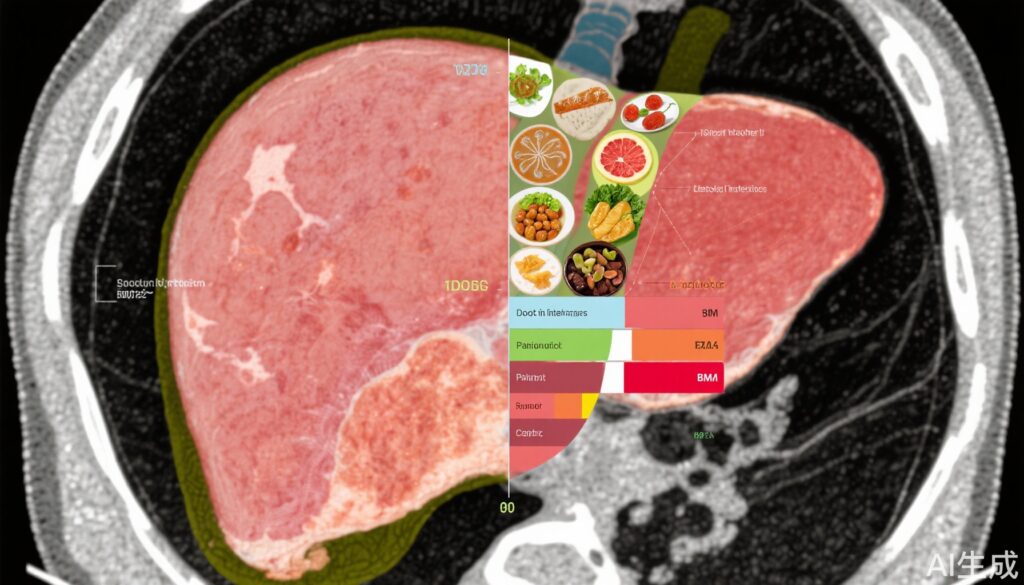Highlights
– Intermittent calorie restriction (ICR, 5:2 diet) produces greater liver fat reduction than standard-of-care (SOC) diets in MASLD, particularly among patients with obesity.
– ICR is as effective as continuous calorie restriction (CCR) and low-carb high-fat (LCHF) diets for hepatic steatosis reduction, with high patient adherence.
– Liver enzyme levels, fibrosis markers, and muscle mass changes are similar between dietary interventions.
– The ICR diet is well tolerated and may offer a flexible, patient-centered approach to managing MASLD and NAFLD.
Study Background and Disease Burden
Metabolic dysfunction-associated steatotic liver disease (MASLD), formerly known as nonalcoholic fatty liver disease (NAFLD), represents the most prevalent chronic liver condition worldwide. MASLD is closely linked with obesity, insulin resistance, and cardiometabolic risk, and can progress to steatohepatitis, fibrosis, cirrhosis, and hepatocellular carcinoma. Despite its high prevalence and serious outcomes, effective pharmacological treatments remain limited, making lifestyle modification—particularly dietary intervention—the cornerstone of management. However, the optimal dietary strategy for reducing liver fat and improving liver-related outcomes remains unclear, with patient adherence and tolerability posing additional challenges.
Study Design
Three recent randomized controlled trials have directly compared intermittent calorie restriction (ICR, commonly the 5:2 diet) to standard-of-care (SOC), continuous calorie restriction (CCR), and low-carb high-fat (LCHF) dietary interventions in patients with MASLD or NAFLD.
1. **Lee et al. (Clin Gastroenterol Hepatol, 2025)**: 72 nondiabetic patients with MASLD (MRI-PDFF ≥8%) randomized to ICR (5:2 diet) or SOC (80% recommended calories), stratified by BMI (≥25 or <25 kg/m2), over 12 weeks. Primary endpoint: ≥30% relative reduction in liver fat content (LFC) via MRI-PDFF.
2. **Wang et al. (NCT04283942)**: 60 adults with MASLD and abnormal glucose metabolism randomized to ICR (2 fasting days/week, 500 kcal/day) or CCR for 12 weeks. Primary endpoint: LFC by 1H-MRS; secondary endpoints: weight, body composition, metabolic markers, liver stiffness.
3. **Berglund et al.**: 74 NAFLD patients randomized to 5:2 diet, LCHF, or SOC for 12 weeks. Primary endpoint: reduction in hepatic steatosis by MRS. Secondary endpoints: transient elastography, insulin resistance, lipids, anthropometrics.
Key Findings
**Liver Fat Content Reduction**
– In Lee et al., 72.2% of ICR patients achieved ≥30% relative LFC reduction versus 44.4% in SOC (P=0.033). Among obese patients, the difference was pronounced (61.1% ICR vs 27.7% SOC, P=0.033); non-obese patients also benefited, though the difference did not reach significance (83.3% ICR vs 61.1% SOC, P=0.352).
– In Wang et al., mean LFC reduction was -20.5% (ICR) vs -15.5% (CCR); the between-group difference was not statistically significant (P=0.15), but ICR trended toward greater reduction.
– Berglund et al. found both 5:2 and LCHF diets superior to SOC for steatosis reduction: LCHF -7.2%, 5:2 -6.1%, SOC -3.6%. No significant difference between 5:2 and LCHF (P=0.41).
**Weight and Body Composition**
– Lee et al.: Overall weight loss was similar between ICR and SOC (-5.3% vs -4.2%, P=0.273); among obese patients, ICR achieved greater weight loss (-5.5% vs -2.9%, P=0.039).
– Wang et al.: No significant differences in weight, lean mass, or insulin resistance between ICR and CCR; ICR showed greater fat mass and HbA1c reduction in exploratory analyses.
– Berglund et al.: Both 5:2 and LCHF diets yielded similar, significant weight losses (~7.3–7.4 kg), much greater than SOC (~2.5 kg).
**Other Metabolic and Liver Outcomes**
– Liver stiffness improved in Berglund et al. for 5:2 and SOC, but not LCHF.
– LDL cholesterol decreased with the 5:2 diet, which was also better tolerated than LCHF (lower dropout rate, fewer adverse effects).
– Across studies, changes in muscle mass, liver enzyme levels, and fibrosis markers were generally comparable between dietary strategies.
**Adherence and Safety**
– Adherence rates were high for both ICR and CCR diets in Wang et al.; the 5:2 diet was more tolerable than LCHF in Berglund et al.
– No serious adverse events were reported across studies.
Expert Commentary
The accumulating evidence supports intermittent calorie restriction as a safe, effective, and flexible dietary strategy for MASLD and NAFLD, particularly beneficial for patients with obesity. The 5:2 regimen’s efficacy is comparable to CCR and LCHF, but its simplicity and higher tolerability may enhance long-term adherence—a critical determinant of success in lifestyle interventions. While the magnitude of liver fat reduction is clinically meaningful, the absence of significant differences in fibrosis progression and liver enzyme normalization underlines the need for longer-term studies and more granular endpoints. Current guidelines from the American Association for the Study of Liver Diseases (AASLD) and EASL emphasize weight loss and caloric restriction but do not yet specify optimal dietary patterns; these studies may inform future updates. Limitations include short intervention duration, modest sample sizes, and limited ethnic diversity. Mechanistic insights suggest that intermittent energy deprivation may enhance hepatic lipid oxidation and improve insulin sensitivity, although further research is required.
Conclusion
Intermittent calorie restriction (5:2 diet) offers a promising, patient-centered approach to reducing liver fat and body weight in MASLD and NAFLD, with efficacy at least comparable to other dietary interventions and superior tolerability. These findings support the integration of ICR as a viable dietary option in clinical practice, tailored to patient preferences and metabolic profiles. Larger, longer-term studies in diverse populations are warranted to refine dietary recommendations and assess impacts on advanced liver disease endpoints.
References
1. Lee HA, Moon H, Kim Y, Lee JK, Lee HA, Kim HY. Effects of Intermittent Calorie Restriction in Nondiabetic Patients With Metabolic Dysfunction-Associated Steatotic Liver Disease. Clin Gastroenterol Hepatol. 2025 Jan;23(1):114-123.e13. doi: 10.1016/j.cgh.2024.06.051.
2. Wang X, et al. Intermittent compared with continuous calorie restriction for treatment of metabolic dysfunction-associated steatotic liver disease: a randomized clinical trial. NCT04283942.
3. Berglund M, et al. Treatment of NAFLD with intermittent calorie restriction or low-carb high-fat diet—a randomised controlled trial.
4. European Association for the Study of the Liver (EASL), Clinical Practice Guidelines: Management of NAFLD. J Hepatol. 2021;75(3):659-689.
5. Chalasani N, et al. The diagnosis and management of NAFLD: Practice guidance from the American Association for the Study of Liver Diseases. Hepatology. 2018;67:328-357.


